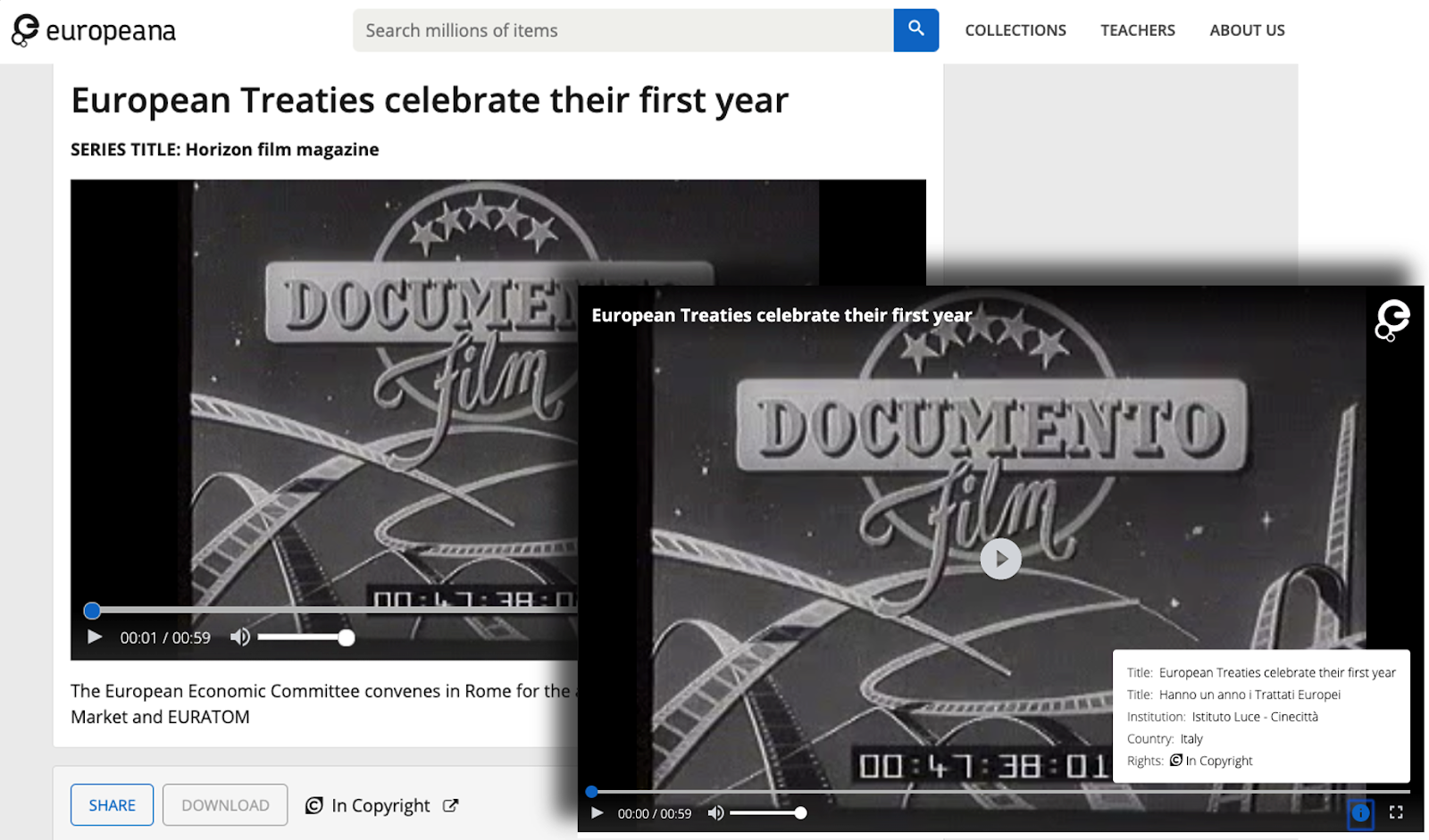In the recently finalized Europeana Media project, co-funded under European Commission’s CEF Generic Services scheme, partners Istituto LUCE, Sound and Vision, the Europeana Foundation, TIB, Noterik and ATiT worked together to provide a novel, open-source universal playout service.
Development focused primarily on the user experience for audio and video materials on the Europeana Collections website. Europeana aggregates materials from a massive variety of collections and organizations across the European continent. The way you encounter video on the site can, therefore, differ enormously. One time you’re looking at a glorious 4K resolution video embedded from YouTube or Vimeo, the next you’re looking at a stamp-sized flash video item uploaded more than a decade ago. We aimed to improve this situation.

Wait, didn’t EUscreen already have a player?
We did! Back in 2015 we launched the current EUscreen portal, which was fully HTML5 based. The previous portal, which had innovative virtual exhibition features and provided the metadata of the videos as linked data, was built on Flash, a technology whose demise had come.
Per request of the content partners in the network, we developed with an anti-download ticketing system. HTML5 didn’t yet have standard approaches to prevent unwarranted downloading. From the get-go, the player supported the W3C Media Fragments standard and was available on our technical partner Noterik’s GitHub under an open-source license. In 2018 we made sure that the player would be embeddable in Europeana.eu via oEmbed, improving the playout experience for the 25 broadcasters and AV archives whose materials you can access via EUscreen.eu. But we wanted more!
Engaging with audiovisual sources
The year is 2020. Media players are all around us and we expect them all to work flawlessly, no matter where content is served from or how old it is. We figured that for a media player to be used on a cultural heritage focused platform, engagement would be key. We held multiple sessions with users to explore how they would use video during research, in the classroom, or for personal use.
Teachers want to be able to embed videos they encounter in course materials. Perhaps even provide some remarks on it, or provide a translation of a short piece that’s in a different language. You may want to create a playlist of materials to keep on watching all the wonders of 20th Century European history sources.
Video editor and subtitle features
Interoperable, too?
When we started the project, we wanted to build on strong, existing, contemporary technologies. One of those was the International Image Interoperability Framework, or IIIF for short. IIIF is a set of standards that provide your browser with information to better handle a multitude of source materials. Originally developed for serving museum or library images (scanned books, newspapers, or massive resolution photos of paintings, for example), the standard branched out into A/V territory in 2016. The development of the IIIF Presentation 3.0 API standard is expected to be finalized in 2020.
In order to provide advanced features such as annotations, subtitles, embedding, and more, we use IIIF-manifests, which is a standard for presentation metadata (ie. information required to generate a viewing experience) in JSON-LD. The IIIF-manifest contains information about the media, information on how it can be displayed, and links to annotations (including subtitles). Our developers committed improvements made to the IIIF AV Component (an implementation developed with funding from the British Library for its Universal Viewer) back to its code base.
What player, where?
You can already experience the player on our EUscreen portal. When you go to our content partner Istituto LUCE’s video collection, and log in with your MyEUscreen account, you’ll be able to use all the features described above. See the video below for a handy walkthrough. We will be rolling out the new player’s features to all collections that grant their permission. On Europeana, all video and audio materials that are provided by content partners are now also streamed via this new player. As Europeana does not yet have user sign-in services, some of the features are not yet available. Our newly instated Task Force on Media Playout in Europeana will continue advocating for this development!
If you’re curious about the insides of the player, take a look at its code base over on the Europeana GitHub. If you would like to comment, know more or have suggestions, please get in touch via info@euscreen.eu!
Europeana Media Team

From left to right: Marco Rendina, Daniel Ockeloen, Abiodun Ogunyemi, Erwin Verbruggen, Margret Plank, Pieter van Leeuwen, Sally Reynolds, Mathy Vanbuel.
Europeana Media is co-financed by the Connecting Europe Facility of the European Union.







